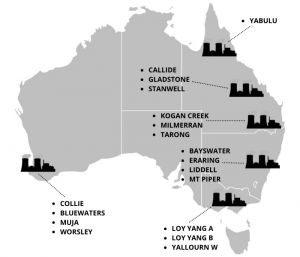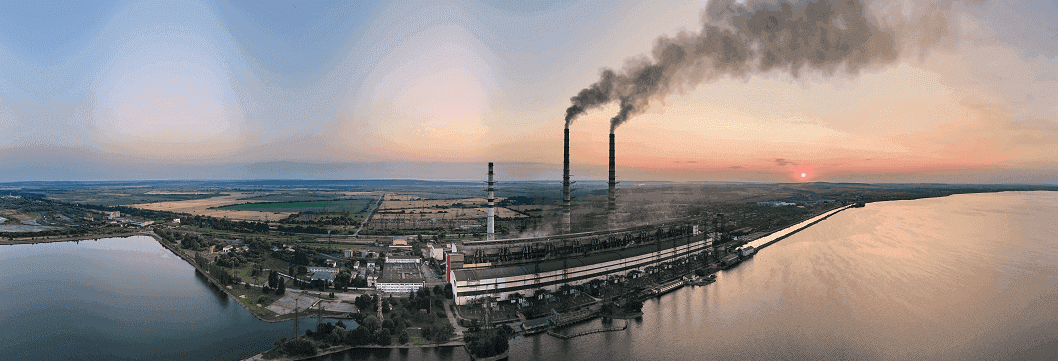KEY POINTS
- There are currently 20 coal-fired power stations operating across Australia.
- A coal-fired power station is an energy plant that burns coal to generate electricity that supplies power to homes and businesses.
- Thermal coal in Australia is either black or brown coal, both of which are flammable sedimentary rocks.
While there are so many initiatives to produce energy from renewable sources, coal is still largely relied on for electricity generation in Australia.
In this guide, Canstar Blue covers the key questions about coal-fired power stations, including the role these plants play in catering to Australia’s energy needs, as well as how they work and where they are located.
On this page:
- What is a coal-fired power station in Australia?
- How many coal-fired power stations are in Australia?
- How do coal-fired power stations in Australia work?
- How long do coal-fired power stations in Australia last?
- Where are the coal-fired power plants in Australia?
- When was the first coal-fired power plant built?
- What is the biggest coal-fired power station in Australia?
- Pros and cons of coal-fired power plants in Australia
- Is coal-fired power being phased out in Australia?
What is a coal-fired power station in Australia?
A coal-fired power station is an energy plant that burns coal — a fossil fuel — to generate electricity to supply homes and businesses. Thermal coal in Australia is either black or brown coal, both of which are flammable sedimentary rocks formed over millions of years from decomposed vegetation that’s been compressed under layers of sand and sediment.
There are a few key energies stored in coal, and when successfully converted, they can create thermal energy, mechanical energy and electrical energy. Australia’s electricity generation relies heavily on coal-fired power stations. In fact, coal-fired power stations supplied about 46% of the country’s power needs in 2023, according to the Department of Climate Change, Energy, the Environment and Water.
How many coal-fired power stations are in Australia?
There are currently 20 coal-fired power stations operating across Australia according to the Open Infrastructure Map. Where a group has multiple stations, they have been combined into one capacity amount. These coal-fired power stations are located in New South Wales, Victoria, Queensland and Western Australia.
Here is a list of the coal-fired power stations currently in operation:
← Mobile/tablet users, scroll sideways to view full table →
| State | Power station | Capacity (MW) |
|---|---|---|
| VIC | Loy Yang A and B | 3,315 (combined) |
| NSW | Eraring | 2,880 |
| NSW | Bayswater | 2,640 |
| QLD | Gladstone | 1,680 |
| QLD | Callide B and C | 1,540 |
| QLD | Stanwell | 1,460 |
| VIC | Yallourn W | 1,450 |
| QLD | Tarong | 1,400 |
| NSW | Mt Piper | 1,320 |
| NSW | Vales Point | 1,320 |
| WA | Muja | 854 |
| QLD | Milmerran | 852 |
| QLD | Kogan Creek | 744 |
| QLD | Tarong North | 450 |
| WA | Bluewaters | 416 |
| QLD | Swanbank | 385 |
| WA | Collie | 340 |
| WA | Worsley Refinery | 114 |
Source: Open Infrastructure Map
How do coal-fired power stations in Australia work?
Coal-fired electricity generation is achieved through a complex process:
- Black or brown coal is pulverised into a powder that’s burned in a furnace
- The heat generated from this turns water fed into the power station into steam, which then passes through turbines at high pressure
- The resulting high-pressure steam helps spin the turbines that are connected to an electrical generator
- Inside the generator are magnets that turn copper wire coils, creating an electrical current that generates electricity
How long do coal-fired power stations last?
According to Energy Networks Australia, the average lifespan of a coal-powered plant is 29 years, although some power stations are designed to last between 40 and 50 years. Most coal power plants have an expected closure date. However, they can cease operating earlier due to a variety of reasons, such as being replaced by renewable energy generation or a reduction in performance that’s likely to increase electricity prices and power outages.
Where are the coal-fired power plants in Australia?
The map below shows some of the main coal-fired power stations in Australia. This map is not to scale and is designed to be a rough guide only. Most coal-fired power stations are located along the east coast of Australia.

When was the first coal-fired power station built?
The first coal-fired power station in Australia is credited to the Yallourn Power station in Victoria. Located in the Latrobe Valley, the origins of the Yallourn Power Station date back to 1920 when operations began at the Yallourn North Open Cut — a brown coal mine. Over the years, the area has consisted of many sites including Yallourn A, B, C, D, E and now, Station W — which is set to close in 2028.
You might also be interested in:
What is the biggest coal-fired power station in Australia?
The largest power station in Australia by capacity is Loy Yang — located in Traralgon, Victoria — which consists of Loy Yang A and Loy Yang B. Both sites generate around 3,310MW, which powers around 30% of Victoria’s energy requirements, according to AGL. Situated next to a coal mine, Loy Yang A is owned by AGL, while Loy Yang B is owned by Chow Tai Fook Enterprises (CTFE) — owner of Alinta Energy.
Loy Yang’s primary fuel source is brown coal. Both plants — A and B — are due to cease operating in June 2035. The power stations’ closure date coincides with the Victorian government’s plans to be completely carbon-neutral by 2050.
Pros and cons of coal-fired power plants in Australia
There are numerous pros and cons for coal and how it helps power Australia. Most of the advantages of coal-fired power stations revolve around the accessibility of coal and how it’s cost-effective when compared to mining other resources, while the disadvantages are centered around its negative impacts on the environment.
← Mobile/tablet users, scroll sideways to view full table →
| Pros of coal power | Cons of coal power |
|---|---|
| No global shortages of coal expected in the medium term | Not a renewable source of energy and relies on a finite resource |
| Australia is a major exporter of coal | Stations emit carbon dioxide |
| Most energy infrastructure supports coal | Aging fleet of power stations |
| Generally cheaper to run than renewables (although this is expected to change as renewables become more cost-effective over time) | Mining of coal can harm natural habitats |
Is coal-fired power being phased out in Australia?
Coal-fired power stations plays a vital role in Australia’s electricity generation capabilities, with it still being the major resource behind keeping our nation’s lights on. That being said, it’s not to say that little black rock isn’t on borrowed time, especially as Australia looks to transform its energy system and reach net-zero emissions by 2050.
Given there is continuous research and investment into green energy production, it’s safe to argue that coal-fired power stations may cease to exist one day. With its future hanging in the balance, there’s no doubt this fossil fuel will remain a talking point for many years to come, particularly as Australia, as well as many other world economies, shift to a more renewable future.
Compare energy plans
If you are looking at cutting costs on your electricity bills, it’s a good idea to compare your current plan with some of the cheapest on the market in your state. If you haven’t switched energy plans in the last 12 months, chances are that you’re on the default market offer and potentially paying more than you need to.
You can begin by looking at your state’s current cheapest offers on the Canstar Blue tool below.
Here are some of the cheapest published deals from the retailers on our database that include a link to the retailer’s website for further details. These are products from referral partners†. These costs are based on the Ausgrid network in Sydney but prices may vary depending on your circumstances. This comparison assumes general energy usage of 3900kWh/year for a residential customer on a single rate tariff. Please use our comparison tool for a specific comparison in your area. Our database may not cover all deals in your area. As always, check all details of any plan directly with the retailer before making a purchase decision.
Here are some of the cheapest published deals from the retailers on our database that include a link to the retailer’s website for further details. These are products from referral partners†. These costs are based on the Citipower network in Melbourne but prices may vary depending on your circumstances. This comparison assumes general energy usage of 4000kWh/year for a residential customer on a single rate tariff. Please use our comparison tool for a specific comparison in your area. Our database may not cover all deals in your area. As always, check all details of any plan directly with the retailer before making a purchase decision.
Here are some of the cheapest published deals from the retailers on our database that include a link to the retailer’s website for further details. These are products from referral partners†. These costs are based on the Energex network in Brisbane but prices may vary depending on your circumstances. This comparison assumes general energy usage of 4600kWh/year for a residential customer on a single rate tariff. Please use our comparison tool for a specific comparison in your area. Our database may not cover all deals in your area. As always, check all details of any plan directly with the retailer before making a purchase decision.
Here are some of the cheapest published deals from the retailers on our database that include a link to the retailer’s website for further details. These are products from referral partners†. These costs are based on the SA Power network in Adelaide but prices may vary depending on your circumstances. This comparison assumes general energy usage of 4000kWh/year for a residential customer on a single rate tariff. Please use our comparison tool for a specific comparison in your area. Our database may not cover all deals in your area. As always, check all details of any plan directly with the retailer before making a purchase decision.
Original reporting by Jared Mullane
Image Source: Bilanol/Shutterstock.com, Wikipedia Commons



Share this article